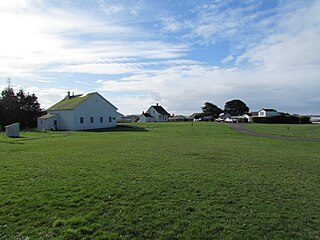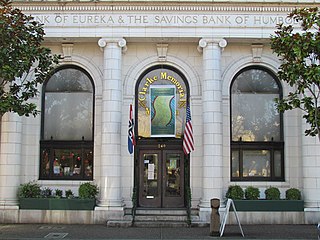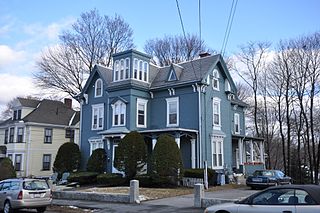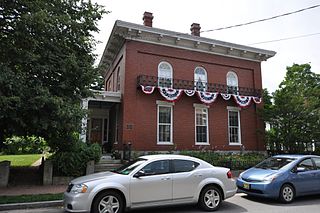
Humboldt County is a county in the U.S. state of California. As of the 2020 census, the population was 136,463. The county seat is Eureka.

Eureka is the principal city and county seat of Humboldt County in the Redwood Empire region of California. The city is located on U.S. Route 101 on the shores of Humboldt Bay, 270 miles (435 km) north of San Francisco and 100 miles (161 km) south of the Oregon border. At the 2010 census, the population of the city was 27,191, and the population of Greater Eureka was 45,034.

Ferndale is a city in Humboldt County, California, United States. Its population was 1,371 at the 2010 census, down from 1,382 at the 2000 census. The city contains dozens of well-preserved Victorian storefronts and homes. Ferndale is the northern gateway to California's Lost Coast and the city, which is sited on the edge of a wide plain near the mouth of the Eel River, is also located near the extensive preserves of coast redwood forests.

Fort Humboldt State Historic Park is a California state park, located in Eureka, California, United States. Displays interpret the former U.S. Army fort, which was staffed from 1853–1870, the interactions between European Americans and Native Americans in roughly the same period, and both logging equipment and local narrow gauge railroad history of the region. Within the collection, there are trains, logging equipment, including a fully functional Steam Donkey engine, and an authentic Native American dug-out canoe. The Fort overlooks Humboldt Bay from a commanding position atop a bluff. The North Coast regional headquarters of the California State Parks system is located onsite.

The Eureka Transit Service is the city fixed-route bus system in Eureka, California. ETS operates four weekday routes between downtown Eureka, Bayshore Mall, Henderson Center, Myrtletown, Cutten, and Pine Hill. Three routes operate on Saturdays. Bus service in Eureka is provided under contract by the Humboldt Transit Authority.

The Clarke Historical Museum in Eureka, California contains the area's premier collection of California North Coast regional and cultural history. The facility has an entire Native American wing, Nealis Hall, which features an extensive internationally recognized collection of basketry, regalia, stoneware, implements, and other objects indicative of the culture and creativity of local and regional Native American groups including the Wiyot, Yurok, Karuk and Hupa Tribes. The Eureka Visitors Center is located in the main hall of the museum. The Clarke Museum is a 501 (c)3 non-profit.

26 Center Avenue in Reading, Massachusetts is an architecturally eclectic cottage, with a mix of Greek Revival, Gothic Revival, and Italianate features. Built c. 1854–1875, it is a rare surviving remnant of a residential subdivision once dubbed "Mudville" for the condition of its unpaved roads. The house was listed on the National Register of Historic Places in 1984.

The Charles Wood House is a historic house at 30 Chestnut Street in Stoneham, Massachusetts. It is one of the most elaborate Italianate houses in Stoneham. The 2+1⁄2-story wood-frame house was built c. 1875 for Charles Wood, who lived there until the first decade of the 20th century. Its basic plan is an L shape, but there is a projecting section on the center of the main facade that includes a flat-roof third-story turret, and the roof line has numerous gables facing different directions. There are porches on the front right, and in the crook of the L, with Stick style decorations, the cornice features heavy paired brackets, some of its windows are narrow rounded windows in a somewhat Gothic Revival style, and the walls are clad in several types and shapes of wooden clapboards and shingles.

The Warsaw Courthouse Square Historic District is a historic district in Warsaw, Indiana that was listed on the National Register of Historic Places in 1982. Its boundaries were increased in 1993.
Stephen Girard Whipple was a 49er, newspaper editor, politician, and a Union officer commanding an all-volunteer "Battalion of Mountaineers" and the Humboldt Military District in the Bald Hills War against the Indians in northwest California during the American Civil War. After the Civil War he was an officer in the U. S. Army serving in the Apache Wars and in the Nez Perce War and at various frontier posts.

The Maxwell Woodhull House is a historic residence located at 2033 G Street in Northwest Washington, D.C.

Nut Grove, also known as the William Walsh House, is a historic house located on McCarty Avenue in Albany, New York, United States. It is a brick building originally designed in the Greek Revival architectural style by architect Alexander Jackson Davis in the mid-19th century. In 1974 it was listed on the National Register of Historic Places.

The Bridge Avenue Historic District is located in a residential neighborhood on the east side of Davenport, Iowa, United States. It has been listed on the National Register of Historic Places since 1983. The historic district stretches from River Drive along the Mississippi River up a bluff to East Ninth Street, which is near the top of the hill.

The Carson Mansion is a large Victorian house located in Old Town, Eureka, California. Regarded as one of the premier examples of Queen Anne style architecture in the United States, the house is "considered the most grand Victorian home in America." It is one of the most written about and photographed Victorian houses in California and possibly also in the United States.

The William D. Roberts House is a historic building located in Provo, Utah, United States. It is listed on the National Register of Historic Places.

The East Brady Street Historic District is located in Milwaukee, Wisconsin. It was added to the National Register of Historic Places in 1990.

The Eureka Theater is an Art Moderne–style cinema built in 1939 in Eureka, California. The movie theater was initially proposed in 1937 as part of a larger development that would include a five-story, 162-room hotel, which was soon scaled back to the theater with flanking commercial spaces. Built by theater magnate George M. Mann, the theater was designed by noted San Francisco designer William B. David, who had once worked in the Metro-Goldwyn-Mayer Art Department in the mid-1930s. The Eureka Theater was considered an ultra-modern movie theater when constructed in 1939 and was an expression of optimism and confidence in Eureka and Humboldt County, California as they pulled out of the Depression. The Eureka Theater ceased showing regularly scheduled movies on August 1, 1996. The theater is currently undergoing restoration, and is available for rent as a performance or event venue.

The Maple Park Historic District is a historic neighborhood that lies northwest of the downtown of Lake Geneva, Wisconsin, United States. Part of the original city plat for Lake Geneva, it was first home to early settlers before the town became known as a retreat for wealthy Chicagoans. The district was added to the National Register of Historic Places in 2005.

The E. Janssen Building at 422 First Street, Eureka, California, is a two-story Italianate commercial building. It was built in 1875 to be a hardware and general merchandise store. In 1973, it was the first building in Eureka to be placed on the United States National Register of Historic Places, and it was listed as a contributing property of the National Register Old Town Eureka Historical District in 1991. From 1998 to 2016, the building housed the HSU First Street Gallery, an art gallery run by Humboldt State University.

The Richardson House, also known as the Captain George McManus House, is a historic house at 11 Lincoln Street in Brunswick, Maine. Built in 1857, it is a fine local example of transitional Greek Revival-Italianate architecture in brick. McManus, for whom it was built, was a prominent local ship's captain. It was listed on the National Register of Historic Places in 1974. For a time, it housed the museum of the Pejepscot Historical Society.




















